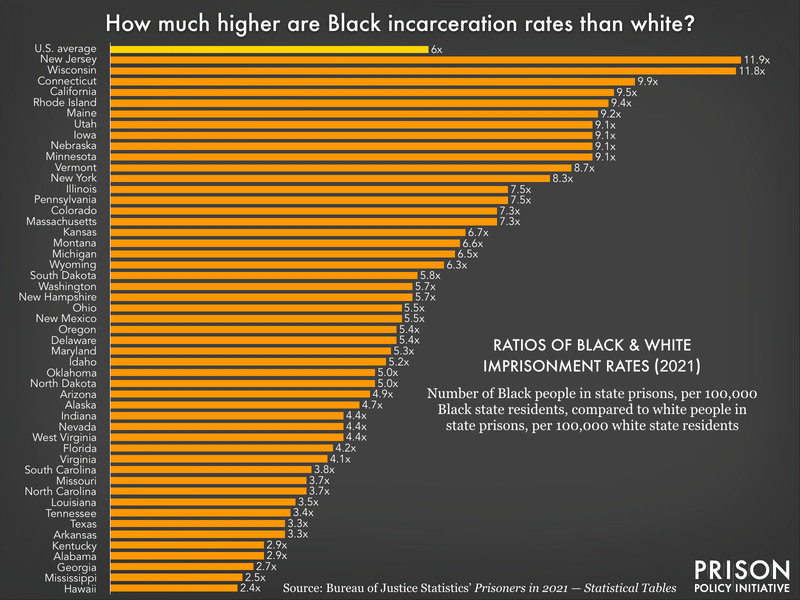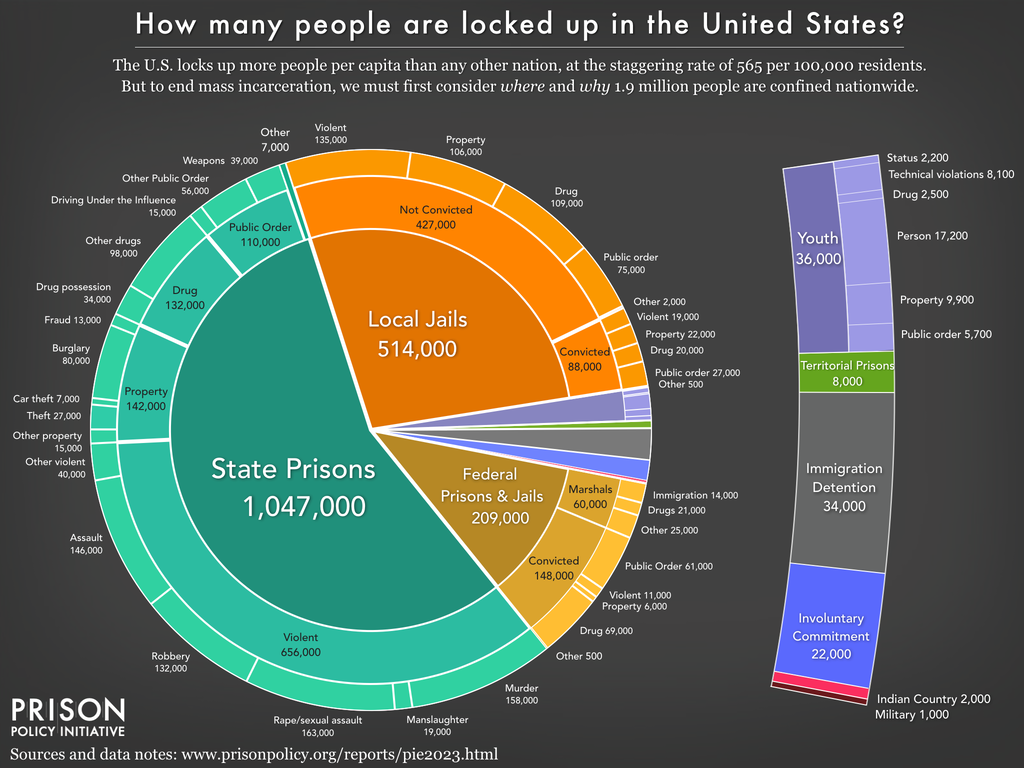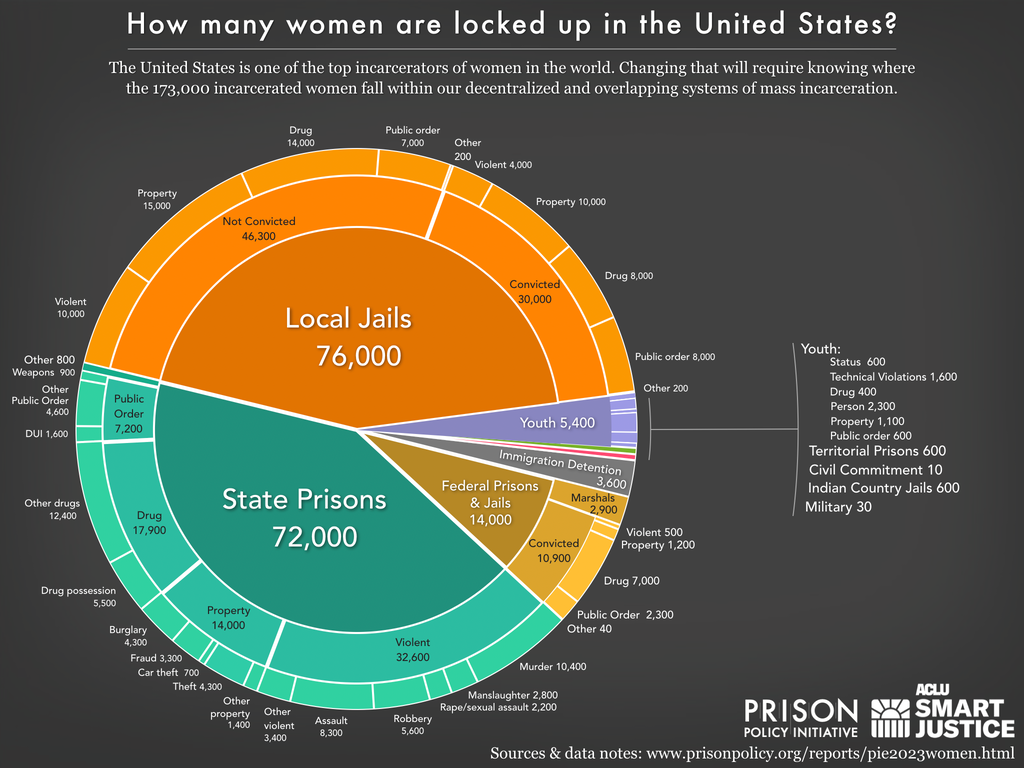12 of our most important reports, briefings, and tools in 2023
New data on the overuse of probation and parole, insights into the racial disparities in prisons and jails, and much more. Here are the highlights of our work in 2023.
by Danielle Squillante, December 21, 2023
2023 was a big year at the Prison Policy Initiative. We exposed how the overuse of probation and parole serves to extend the prison walls into our communities, produced new datasets and graphics that show just how vast the racial disparities in prisons and jails actually are, and highlighted how the same companies that profited off of over-priced prison phone calls have moved into the e-messaging industry. Didn’t catch everything we published in 2023? We’ve curated a list of some of our best work from this year below.
Mass Incarceration: The Whole Pie 2023
We released an update of our flagship report, which provides the most comprehensive view of how many people are locked up in the U.S., in what kinds of facilities, and why. It pieces together the most recent national data on state prisons, federal prisons, local jails, and other systems of confinement to provide a snapshot of mass incarceration in the U.S.
Women experience a dramatically different criminal legal system than men do, but data on their experiences is difficult to find and put into context. To fill these data gaps, we also released an updated Women’s Whole Pie report in partnership with the ACLU Campaign for Smart Justice, which includes richly-annotated data visualizations about women behind bars.
Punishment Beyond Prisons 2023
Our report shows the full picture of correctional control in the U.S., with a particular focus on the overuse of probation and parole. It includes data for all 50 states and D.C. on the number of people under correctional control, including community supervision. We’ve designed this report specifically to allow state policymakers and residents to assess the scale and scope of their entire correctional systems. Our findings raise the question of whether probation and parole systems are working as intended or whether they simply funnel people into prisons and jails — or are even replicating prison conditions in the community.

SMH: The rapid & unregulated growth of e-messaging in prisons
To better understand the explosive growth in e-messaging, we examined all 50 state prison systems, as well as the Federal Bureau of Prisons (BOP), to see how common this technology has become, how much it costs, and what, if anything, is being done to protect incarcerated people and their families from exploitation. Our review found that, despite its potential to keep incarcerated people and their families connected, e-messaging has quickly become just another way for companies to profit at their expense.

Updated data and charts: Incarceration stats by race, ethnicity, and gender for all 50 states and D.C.
We released new data visualizations and updated tables showing the national landscape of persistent racial disparities in state prisons and local jails. Unlike other datasets, ours provides apples-to-apples state comparisons in three formats: counts, rates, and percentages. Using this data, we’ve updated over 100 of the key graphics on our State Profile pages, showing prison and jail incarceration rates by race and ethnicity, and how the racial composition of each state’s prisons and jails compares to the total state population.

What is civil commitment? Recent report raises visibility of this shadowy form of incarceration
Twenty states and the federal Bureau of Prisons detain over 6,000 people, mostly men, who have been convicted of sex-related offenses in prison-like “civil commitment” facilities beyond the terms of their criminal sentence. This deep dive into recently-published data from a survey of individuals confined in an Illinois civil commitment facility sounds the alarm about how these “shadow prisons” operate and the high rates of violence and trauma that people detained in the facilities are subjected to.

The aging prison population: Causes, costs, and consequences
Our briefing examines the inhumane, costly, and counterproductive practice of locking up older adults. The U.S. prison population is aging at a much faster rate than the nation as a whole — and older adults represent a growing portion of people who are arrested and incarcerated each year. And while prisons and jails are unhealthy for people of all ages, older adults’ interactions with these systems are particularly dangerous, if not outright deadly.
How 12 states are addressing family separation by incarceration — and why they can and should do more
Our briefing assesses the legislative action taken by 12 states and the federal government to address the growing crisis of family separation caused when a primary caregiver is incarcerated. All too often, incarceration destroys family bonds as parental rights are terminated or children end up in foster care. We explain how advocates across the country are fighting for creative and holistic solutions.

No Release: Parole grant rates have plummeted in most states since the pandemic started
With parole board practices in the news, we thought it was important to look around the country and evaluate the direction in which state parole boards are moving. We surveyed 27 states and found only 7 saw an increase in their parole approval rate since the pandemic began, and almost every state held substantially fewer hearings than in years past.

Breaking news from inside: How prisons suppress prison journalism
In response to a move by New York prison officials in May to introduce a policy to effectively suppress prison journalism, we released a briefing building off of data from the Prison Journalism Project that detailed restrictions on prison journalism in prison systems across the country. Prison journalism affirms some of our most basic democratic principles — the exercise of speech free from government influence — and is an essential check on the extreme power these institutions wield over life and death.
A profile of Native incarceration in the U.S.
Adding to our 50 State Profile pages, we’ve created a profile of Native incarceration in the United States to illuminate what data exists about the mass incarceration of Native people. Native people are incarcerated in state and federal prisons at a rate of 763 per 100,000 people. This is double the national rate and more than four times higher than the state and federal prison incarceration rate of white people. In publishing this profile of Native incarceration, we are hoping to make the existing information more accessible, while also acknowledging the layers of systemic oppression impacting Native people in the criminal legal system.
States to the Census Bureau: You created prison gerrymandering, you need to end it.
Prison gerrymandering is a problem created by the Census Bureau’s policy of counting incarcerated people as residents of prison cells rather than their home communities. In a May blog post, we reviewed a new National Conference of State Legislatures report that outlines the experiences and recommendations from states that implemented anti-prison gerrymandering reforms in the 2020 redistricting cycle. The report makes clear that state officials agree that prison gerrymandering is important, worth fixing, and the Census Bureau should be responsible for ending it. With roughly half of U.S. residents now living in a state that has taken action to end prison gerrymandering, the emerging consensus on this issue is clear. But will the Bureau listen?

Advocacy Toolkit
We continue to update our Advocacy Toolkit, a collection of web-based resources designed to improve advocates’ skills (such as locating data and conducting public records requests) or to plug directly into their campaigns (such as fighting new jail proposals). New this year is a guide to help advocates identify ways public housing policies can be more inclusive to people with criminal histories, as well as a guide that explains why charge-based carveouts are problematic and provides messaging to combat justifications for including them in criminal justice reforms.
This is only a small piece of the important and impactful work we published in 2023 and our work is far from over. We’ve got big things planned in 2024, when we’ll continue to expose the broader harms of mass criminalization and highlight solutions that keep our communities safe without expanding prisons, jails, and the carceral system.





